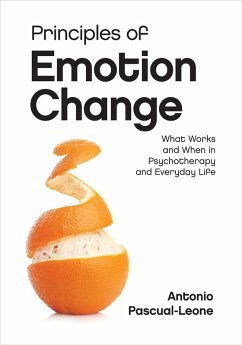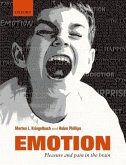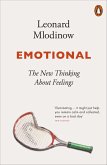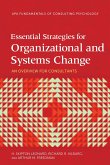Antonio Pascual-Leone
Principles of Emotion Change
What Works and When in Psychotherapy and Everyday Life
Antonio Pascual-Leone
Principles of Emotion Change
What Works and When in Psychotherapy and Everyday Life
- Broschiertes Buch
- Merkliste
- Auf die Merkliste
- Bewerten Bewerten
- Teilen
- Produkt teilen
- Produkterinnerung
- Produkterinnerung
This theoretical and practical book explores the nature of emotion and emotion change in therapy.
Andere Kunden interessierten sich auch für
![Emotion Emotion]() Morten KringelbachEmotion58,99 €
Morten KringelbachEmotion58,99 €![Emotional Emotional]() Leonard MlodinowEmotional9,99 €
Leonard MlodinowEmotional9,99 €![Oxford Companion to Emotion and the Affective Sciences Oxford Companion to Emotion and the Affective Sciences]() David SanderOxford Companion to Emotion and the Affective Sciences56,99 €
David SanderOxford Companion to Emotion and the Affective Sciences56,99 €![Essential Strategies for Organizational and Systems Change Essential Strategies for Organizational and Systems Change]() H Skipton LeonardEssential Strategies for Organizational and Systems Change48,99 €
H Skipton LeonardEssential Strategies for Organizational and Systems Change48,99 €![Group Psychodynamic-Interpersonal Psychotherapy Group Psychodynamic-Interpersonal Psychotherapy]() Giorgio A TascaGroup Psychodynamic-Interpersonal Psychotherapy58,99 €
Giorgio A TascaGroup Psychodynamic-Interpersonal Psychotherapy58,99 €![Multicultural Care Multicultural Care]() Lillian Comas-DíazMulticultural Care71,99 €
Lillian Comas-DíazMulticultural Care71,99 €![Multicultural Therapy Multicultural Therapy]() Melba J T VasquezMulticultural Therapy40,99 €
Melba J T VasquezMulticultural Therapy40,99 €-
-
-
This theoretical and practical book explores the nature of emotion and emotion change in therapy.
Produktdetails
- Produktdetails
- Verlag: American Psychological Association (APA)
- Seitenzahl: 658
- Erscheinungstermin: 16. Dezember 2025
- Englisch
- ISBN-13: 9781433836602
- ISBN-10: 1433836602
- Artikelnr.: 70162154
- Herstellerkennzeichnung
- Libri GmbH
- Europaallee 1
- 36244 Bad Hersfeld
- gpsr@libri.de
- Verlag: American Psychological Association (APA)
- Seitenzahl: 658
- Erscheinungstermin: 16. Dezember 2025
- Englisch
- ISBN-13: 9781433836602
- ISBN-10: 1433836602
- Artikelnr.: 70162154
- Herstellerkennzeichnung
- Libri GmbH
- Europaallee 1
- 36244 Bad Hersfeld
- gpsr@libri.de
Antonio Pascual-Leone, PhD, CPsych, is a professor in psychology at the University of Windsor, Canada and is an honorary professor of psychiatry at the University of Lausanne, Switzerland. Dr. Pascual-Leone runs the Emotion Change Lab at the University of Windsor and supervises research on the processes of emotional change as they occur in psychotherapy and in everyday life. Dr. Pascual-Leone usually teaches courses on psychotherapy interventions and has co-authored a book on Emotion-Focused Therapy with Dr. Sandra C. Paivio. He has published seminal contributions to the theory and research of emotion-focused therapy and is regarded as a world expert in emotional processing. His work is recognized by career awards from international societies as well as distinguished publication awards.
Introduction
CHAPTER 1: A General Theory of Emotional Change
PART I – REDUCE INTENSITY
CHAPTER 2: Down-Regulating Emotional Intensity
CHAPTER 3: Avoidance, Desensitization, and Behavioral Coping
PART II: NOTICE THE FEELING
CHAPTER 4: Emotional Awareness: From Engagement to Symbolization
CHAPTER 5: Emotional Engagement: Getting in Touch With What’s There
CHAPTER 6: Labeling Emotion: Finding Just the Right Words
CHAPTER 7: Deepening Emotion Through Symbolization
PART III: FEEL MORE, EXPRESS MORE
CHAPTER 8: Heightening Arousal, Vividness, Expression, and Enactments
CHAPTER 9: Getting Physical: Working From the Outside In
CHAPTER 10: Enactments: Working From the Inside Out
CHAPTER 11: Proclamation of Self: “I Felt It, I Said It, I Did It!”
PART IV: ORDER THE SEQUENCE OF EMOTIONS
CHAPTER 12: Sequential Transformation: The Pattern in Emotion Makes the
Change
CHAPTER 13: Changing Emotion With Emotion: The Process in Action
CHAPTER 14: Adult Emotional Development: Expanding One’s Repertoire
CHAPTER 15: The Sequential Model: “The Only Way Out is Through”
CHAPTER 16: Tracking Sequences: The Roller Coaster to Resolution
PART V: PUT THE FEELING IN CONTEXT
CHAPTER 17: Using Context and Narrative: “The Big Picture”
CHAPTER 18: Psychological Elaboration: Telling More of the Story
CHAPTER 19: We Have Relationship With Our Memories: Revising the
“Meta-Data”
CHAPTER 20: Stepping Out of the Frame: “I Am Myself and My Circumstances”
CHAPTER 21: Life Narrative and Identity: The Story Itself Is an Agent of
Change
CHAPTER 22: Storying the Self: “It’s a Matter of Perspective . . ."
CHAPTER 23: Having Purpose and Making Choices
PART VI: CONCLUSIONS: A NEW PARADIGM
CHAPTER 24: A General Theory of Emotion Change
References
Index
About the Author
CHAPTER 1: A General Theory of Emotional Change
PART I – REDUCE INTENSITY
CHAPTER 2: Down-Regulating Emotional Intensity
CHAPTER 3: Avoidance, Desensitization, and Behavioral Coping
PART II: NOTICE THE FEELING
CHAPTER 4: Emotional Awareness: From Engagement to Symbolization
CHAPTER 5: Emotional Engagement: Getting in Touch With What’s There
CHAPTER 6: Labeling Emotion: Finding Just the Right Words
CHAPTER 7: Deepening Emotion Through Symbolization
PART III: FEEL MORE, EXPRESS MORE
CHAPTER 8: Heightening Arousal, Vividness, Expression, and Enactments
CHAPTER 9: Getting Physical: Working From the Outside In
CHAPTER 10: Enactments: Working From the Inside Out
CHAPTER 11: Proclamation of Self: “I Felt It, I Said It, I Did It!”
PART IV: ORDER THE SEQUENCE OF EMOTIONS
CHAPTER 12: Sequential Transformation: The Pattern in Emotion Makes the
Change
CHAPTER 13: Changing Emotion With Emotion: The Process in Action
CHAPTER 14: Adult Emotional Development: Expanding One’s Repertoire
CHAPTER 15: The Sequential Model: “The Only Way Out is Through”
CHAPTER 16: Tracking Sequences: The Roller Coaster to Resolution
PART V: PUT THE FEELING IN CONTEXT
CHAPTER 17: Using Context and Narrative: “The Big Picture”
CHAPTER 18: Psychological Elaboration: Telling More of the Story
CHAPTER 19: We Have Relationship With Our Memories: Revising the
“Meta-Data”
CHAPTER 20: Stepping Out of the Frame: “I Am Myself and My Circumstances”
CHAPTER 21: Life Narrative and Identity: The Story Itself Is an Agent of
Change
CHAPTER 22: Storying the Self: “It’s a Matter of Perspective . . ."
CHAPTER 23: Having Purpose and Making Choices
PART VI: CONCLUSIONS: A NEW PARADIGM
CHAPTER 24: A General Theory of Emotion Change
References
Index
About the Author
Introduction
CHAPTER 1: A General Theory of Emotional Change
PART I – REDUCE INTENSITY
CHAPTER 2: Down-Regulating Emotional Intensity
CHAPTER 3: Avoidance, Desensitization, and Behavioral Coping
PART II: NOTICE THE FEELING
CHAPTER 4: Emotional Awareness: From Engagement to Symbolization
CHAPTER 5: Emotional Engagement: Getting in Touch With What’s There
CHAPTER 6: Labeling Emotion: Finding Just the Right Words
CHAPTER 7: Deepening Emotion Through Symbolization
PART III: FEEL MORE, EXPRESS MORE
CHAPTER 8: Heightening Arousal, Vividness, Expression, and Enactments
CHAPTER 9: Getting Physical: Working From the Outside In
CHAPTER 10: Enactments: Working From the Inside Out
CHAPTER 11: Proclamation of Self: “I Felt It, I Said It, I Did It!”
PART IV: ORDER THE SEQUENCE OF EMOTIONS
CHAPTER 12: Sequential Transformation: The Pattern in Emotion Makes the
Change
CHAPTER 13: Changing Emotion With Emotion: The Process in Action
CHAPTER 14: Adult Emotional Development: Expanding One’s Repertoire
CHAPTER 15: The Sequential Model: “The Only Way Out is Through”
CHAPTER 16: Tracking Sequences: The Roller Coaster to Resolution
PART V: PUT THE FEELING IN CONTEXT
CHAPTER 17: Using Context and Narrative: “The Big Picture”
CHAPTER 18: Psychological Elaboration: Telling More of the Story
CHAPTER 19: We Have Relationship With Our Memories: Revising the
“Meta-Data”
CHAPTER 20: Stepping Out of the Frame: “I Am Myself and My Circumstances”
CHAPTER 21: Life Narrative and Identity: The Story Itself Is an Agent of
Change
CHAPTER 22: Storying the Self: “It’s a Matter of Perspective . . ."
CHAPTER 23: Having Purpose and Making Choices
PART VI: CONCLUSIONS: A NEW PARADIGM
CHAPTER 24: A General Theory of Emotion Change
References
Index
About the Author
CHAPTER 1: A General Theory of Emotional Change
PART I – REDUCE INTENSITY
CHAPTER 2: Down-Regulating Emotional Intensity
CHAPTER 3: Avoidance, Desensitization, and Behavioral Coping
PART II: NOTICE THE FEELING
CHAPTER 4: Emotional Awareness: From Engagement to Symbolization
CHAPTER 5: Emotional Engagement: Getting in Touch With What’s There
CHAPTER 6: Labeling Emotion: Finding Just the Right Words
CHAPTER 7: Deepening Emotion Through Symbolization
PART III: FEEL MORE, EXPRESS MORE
CHAPTER 8: Heightening Arousal, Vividness, Expression, and Enactments
CHAPTER 9: Getting Physical: Working From the Outside In
CHAPTER 10: Enactments: Working From the Inside Out
CHAPTER 11: Proclamation of Self: “I Felt It, I Said It, I Did It!”
PART IV: ORDER THE SEQUENCE OF EMOTIONS
CHAPTER 12: Sequential Transformation: The Pattern in Emotion Makes the
Change
CHAPTER 13: Changing Emotion With Emotion: The Process in Action
CHAPTER 14: Adult Emotional Development: Expanding One’s Repertoire
CHAPTER 15: The Sequential Model: “The Only Way Out is Through”
CHAPTER 16: Tracking Sequences: The Roller Coaster to Resolution
PART V: PUT THE FEELING IN CONTEXT
CHAPTER 17: Using Context and Narrative: “The Big Picture”
CHAPTER 18: Psychological Elaboration: Telling More of the Story
CHAPTER 19: We Have Relationship With Our Memories: Revising the
“Meta-Data”
CHAPTER 20: Stepping Out of the Frame: “I Am Myself and My Circumstances”
CHAPTER 21: Life Narrative and Identity: The Story Itself Is an Agent of
Change
CHAPTER 22: Storying the Self: “It’s a Matter of Perspective . . ."
CHAPTER 23: Having Purpose and Making Choices
PART VI: CONCLUSIONS: A NEW PARADIGM
CHAPTER 24: A General Theory of Emotion Change
References
Index
About the Author








